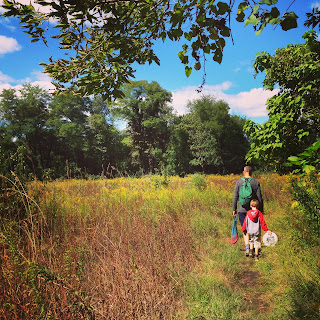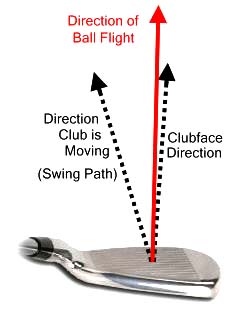As we drove around the corner leading into our favorite course my wife said, "Oh jeez, look at all the cars in the parking lot." The adjoining driving range was closed for the season, but because of the unseasonably warm weather the course was hopping. She went on with concerns about a tournament and wondered if we could get out. Drawing on my experience of managing high volume golf courses, I assured her that there would be no problems. We were a foursome that included our two boys, ages five and two. This was our family outing for the week and we were not going anywhere else.
We grabbed our gear, snacks and drinks and started toward the group of people collecting behind the 18th hole. The variety of people made the atmosphere inviting. There was a lot of jabbing while others told tall tales of high flying shots and low roped bullets. A clank at the 18th sounded like chained tires in the snow as the crowd stirred in disbelief at the hole-out from some 30 yards. As we made our way through I could see the first tee. There was a single player loosening up posing like a windmill as he stretched his back. Once I got through the crowd I could see his approach.
The first is a short par 3 down a subtle slope to the left. He needed only to manage a smattering of trees that were widely scattered between he and the hole. Then he made his move. He started from well behind the tee markers side stepping toward the line. He was right handed as he wound up turning his upper body away from the target. Once his momentum reached max speed toward the target his lower body came to a screeching halt as his whirling arm and hand released a stinging disc down the right side. It bent around the first set of trees on the right with a gentle bend to the left landing within scoring distance. He had a great start. This wasn't his first day at the Sedgley Woods Disc Golf Course.
We play disc golf almost every weekend, spring through fall. Today, just several days before New Years in Philadelphia the temperature was above 50 degrees. My experience is always the same. Complete satisfaction! A perfect blend of exercise, sport, exploration, and child rearing. I have skied and golfed since I was five years old. I have done a little backpacking and even bagged a few "fourteeners" while living in Denver. Throw in a mountain bike and a pair of trail runners and I'd say I've dabbled with a fair share of outdoor sports. Disc golf fills the void for outdoor activity with an edge.
Complete satisfaction!
A perfect blend of exercise, sport, exploration, and child rearing
Maybe it's the desire to lower my standards regarding course conditions. Maybe the time needed. Maybe the cost. Maybe the thrill of the hike or jog which is more exploratory than ruled by etiquette. It's okay to be loud. It's okay to run on the greens (there are none). There is no pressure from behind. There is rarely any wait despite the course being full. And while my two year old was slung on my back for 12 holes, he trailed and wandered along with us for the final six. It was muddy. Boots and sneakers were a mess. The atmosphere was completely relaxing, aside from the occasional stress of losing a disc, which is only slightly more expensive than the Titleist balls in my golf bag. The time was almost thoughtless. If nothing else, I was mindful of where my kids were, never out of sight and most often out of danger of a high flying arrant disc.
Yes, there are disc golf professionals, and serious tournaments that mirror the regional golf pro ranks. But, even that group is completely inviting for a family of four to take part during the day. There is no worry of un-raked bunkers, missed pitch marks on the green, and no worry of waiting. The emphasis is not particularly on the length of time. It is on the amount of time we need to play. Playing through a group or vise-versa has no stigma on a disc golf course. Not once in seven years playing at the same course have we encountered any stress related to the pace, regardless of whether we were slow or fast. And we've been both.
This idea makes me think about recent efforts by the PGA of America and golf associations to pick up the pace at your club. I wonder if that is actually hitting at the core. I agree the pace needs to increase. But does that mean the experience should be better for some and not for others. Should a foursome of friends that know they will play comfortably in four and a half hours be pushed, ridiculed or reported. If the foursome behind typically play in 3:45, this is a recipe for disaster, conflict, and ill feelings. I, for one, don't like conflict.
The PGA tour is partially at fault. I know, I know... they are playing for a gazillion dollars. But I don't think that should factor in at all. None. The game has a time limit and that rule is broken every weekend. If it seems like a gray rule, they simply need to enforce it. What if my free throw routine was three minutes long? I would never run the court. Or my pitching routine was five minutes? I would never play in any league. 18 holes of golf was never meant to be played in six hours. Or even five, but I've played courses that warranted that amount. So, again, it's not simply about the time allotted. It's about the time my group needs to finish the round, within reason. There's that gray color again. Where is the line drawn?
 The reason there is no pace of play issues at my local disc golf course on a packed Saturday afternoon is because everyone is cordial. There is no stigma with letting someone play through. Those that are playing through are patient. It happens fast and early in the round if necessary. It is seamless because all players involved play together for a short time moving their disc forward, a process I have always suggested on the golf course. It's a version of "ready golf" for about two minutes. Too often the slow group stops to wait, further slowing themselves down and increasing the backup behind them. Is simply pushing people to play faster really the answer?
The reason there is no pace of play issues at my local disc golf course on a packed Saturday afternoon is because everyone is cordial. There is no stigma with letting someone play through. Those that are playing through are patient. It happens fast and early in the round if necessary. It is seamless because all players involved play together for a short time moving their disc forward, a process I have always suggested on the golf course. It's a version of "ready golf" for about two minutes. Too often the slow group stops to wait, further slowing themselves down and increasing the backup behind them. Is simply pushing people to play faster really the answer?Do you have thoughts about the pace of play at your club? How about the PGA Tour? Do you play disc golf? Leave a comment and let's chat about it. HAPPY NEW YEAR!







